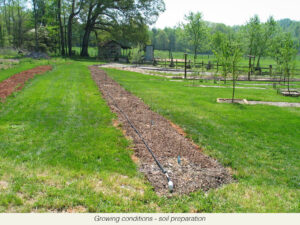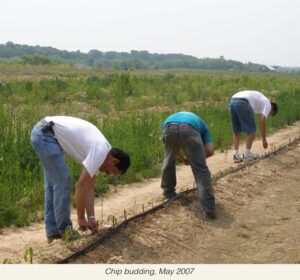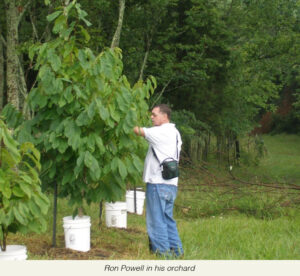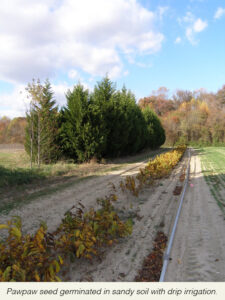Growing Conditions
Soil
Pawpaws have flexible soil requirements. Good drainage is critical. Soil pH should be moderately acid to neutral, in the range of 5.5 to 7.0. Pawpaws are happiest in a rich, deep, loamy soil with high organic matter content. In addition, they appreciate an organic mulch. In the wild, a natural mulching layer of decomposing leaves is normally present. Excessively dry sites should be avoided. Moist soils are ideal.
Climate
Pawpaws are native to the humid temperate climate of eastern North America. They are hardy to at least -20° F (-28° C). They require a approximately 400 hours of chilling to break dormancy. This requirement varies with provenance: pawpaws of northern origin require more chilling than cultivars of southern origin. Hence, pawpaws grow best in USDA Hardiness Zones 5-8. See this link for a hardiness zone map.
They need a minimum of 30 inches (approx. 75 cm) of rainfall annually with the majority of that falling in spring and summer. They need a long warm summer to ripen the fruit — at a minimum 150 frost-free days and 2200 GDD (Growing Degree Days).
Site and Spacing
The pawpaw is a small tree that typically grows to about 20 feet (7 m) high and less broad. In an orchard setting, tree centers should be at least 10 feet (3 m) apart. Row widths depend on the size of tractors and equipment — 20 foot (7 m) rows may be a minimum width. When raising just a few trees for fruit, it is advisable to plant them close — no further than 30 feet (10 m) apart — in order to ensure good pollination, as the flowers are insect pollinated and as the trees are self infertile. For good fruit production the trees should be grown in full sun. While it is true that pawpaws are shade tolerant, they will fruit much less in the shade. Because of the large size of the leaves, windy sites are damaging and to be avoided.
Establishing Young Trees
Prepare the soil in advance of receiving your young pawpaw tree. The soil from the hole should be thoroughly loosened to a fine tilth. The hole should be the same depth as the root system, and 2 or 3 times the diameter of the root mass. In an orchard setting, we recommend you plow a furrow down the row, rototill the soil to a loose tilth, and then mound the soil into raised beds. Pawpaw trees do not have fibrous roots. Their roots are fleshy, similar to magnolia. And like magnolia, pawpaws transplant better if moved in the spring, not the fall. However, container grown stock can be planted virtually anytime during the growing season. For the first growing season keep the trees well watered. Do not overwater, however. Drowning the tree is bad. Keep the area completely free of weeds & all competing vegetation up to a 2-foot radius. Weed control is essential to successful establishment. Pawpaw is almost the last tree to leaf out in spring, a trait reflecting its tropical origins. The young leaves often appear chlorotic. Don’t worry. This is a temporary springtime condition. Chlorosis on mature leaves is a different matter, however.
Discussion Re: Bleach Taste in Fruit, Causes, Remedies
June 1, 2018
Hi Neal,
I first started planting pawpaws about 15 years ago and over time have built up a nice patch of a number of named cultivars, some of which I bought from the late John Gordon and some of which I got from you and other places online. They’ve all grown great here in Western NY Rochester area (Zone 6A / 5B) and are vigorous, looking very well. They put out lots of flowers and I’ve no trouble with natural pollination. We always have a ton of fruit set as well, so much that if I don’t thin it a bit the trees occasionally take damage when it gets heavy and there’s a storm.
The one problem is that my whole family (me included) thinks the fruit tastes/smells bad, a bit like bleach. (All the cultivars, doesn’t matter). Over the years I’ve experimented with the harvest time and while extra ripeness helps, the off-taste is still there no matter when we pick them, from green to brown mush.
I’ve looked all over for other people experiencing this and no luck. Everybody online and YouTube raves about them. Unfortunately, I’ve never tasted others but our own and I’m wondering if the growing conditions ours in are slightly off which is affecting the taste . Our pH for example is neutral to slightly basic (7.0-7.2), rather that a bit on the acidic side. Or perhaps some missing soil micro-nutrient? The soil is very sandy. The roots are never wet. If anything, they are shorted water, but the trees never show any drought stress.
So, any idea any conditions which could be affecting our fruit? I so want to like these things and the trees themselves are super-healthy. If I knew where some other trees were locally, I’d surely taste-taste their fruit, but ours is the only patch I know of.
thanks so much with any help you can supply,
Jim Burkhard
Churchville, NY
________________________________________
Jim,
This is peculiar. Perhaps I have encountered a couple pawpaw trees whose fruit is off flavor, like bleach. But this is out of more than 1000. I have but two ideas. Your pH is neutral to alkaline. Obviously, your trees are healthy, but maybe nutrient availability is off, affecting taste. pH does alter the availability of elements for all plants. Best pH range for pawpaw is 4.5 to 6.5. Sulfur can correct this —- or read up on nutrients that are short when pH is neutral. Let me know what you find out.
Neal
________________________________________
September 25, 2018
This year, I was increasing puzzled about why everyone else online raves about them except our family. So, I did online research and examined my growing conditions. I finally tested (home chemical kit) the soil for nutrients and discovered my soil is very low in all major nutrients N, P, and K. (Neal’s comment: N-P-K is often low in sandy soil that lacks organic matter.)
I’m an engineer, so I hate to deal with problems with a shotgun approach, but since I have only one batch of trees (no separate “control” planting) and one crop of fruit a year, I figured I would brute force deal with the obvious issues at once this year and then adopt more proper methodology in the future:
• I applied granulated sulfur in early July an application rate sufficient to drop the pH 0.1 point.
• I applied a moderate 10-10-10 fertilizer to make up the major nutrient weakness.
• I applied a moderate dose of HollyTone to supply possibly lacking micronutirents.
• I applied a moderate dose of gypsum on the advice of Facebook Pawpaw people.
•
About a week ago the trees started dropping fruit and I sampled it from the varied trees. Amazingly, they all tasted great, with virtually no evidence of the prior problem — the improvement from my past years of experience has been most dramatic. I also passed a box of fruit to a gentleman who is familiar with proper pawpaw taste. He critiqued them as tasting very good — “right in bounds” with his past experience.
Sincerely,
Jim Burkhard
Chili, NY
Growing Conditions Gallery






